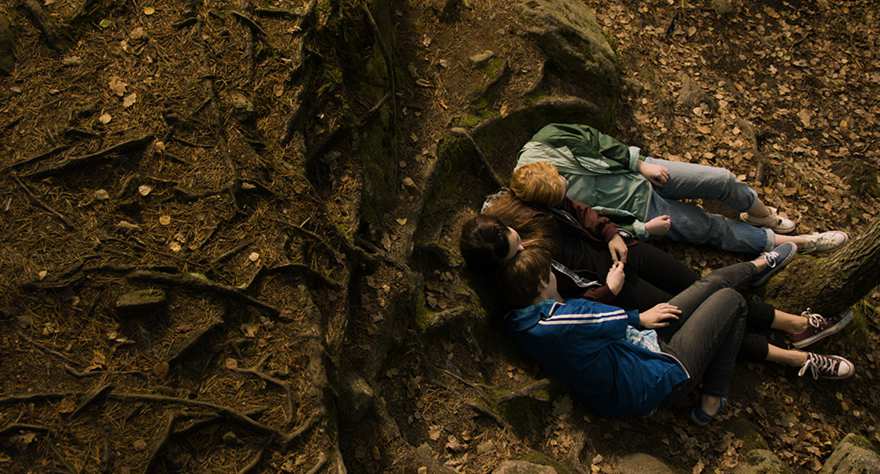
Three outcast girls get a look at life through boys' eyes in this mystical gender-bending drama.

Three outcast girls get a look at life through boys' eyes in this mystical gender-bending drama.
Living in front of cameras that never stop rolling and existing in the presence of an often vicious social media congregation, Caitlyn Jenner, who for four decades had best been known as US Olympic hero Bruce Jenner, announced she was transgender. It’s a new thing for most people, this transgenderism, but Jenner has brought it to the forefront of the world’s mind. And while there are a lot of questions the world might have about those identifying as transgender, the one that keeps coming to my mind is this: how much pain have transgenders suffered while spending lifetimes pretending to be something they are not?
Director Alexandra-Therese Keining’s drama, Girls Lost, looks at the genesis of that kind of pain when a teen wonders if she is actually a boy trapped in a girl’s body.
Kim, Momo, and Bella (respectively Tuva Jagell, Louise Nyvall, and Wilma Holmén) are the closest of friends and they need to be. Outcasts at school, the teen trio are physically and verbally bullied on a regular basis—at times brutally so—by classmates who are enraged only by the hateful notion the girls might be lesbians. Nothing more. Their teachers allow the bullying to happen.
One day, while seeking solace in the greenhouse in Bella’s back yard, the girls find a mysterious-looking seed among the usual horticultural fare. They plant it, and by morning a flower is fully grown. Burning with curiosity (but understandably a little scared), the girls drink nectar from the flower. Soon after, they magically transform into boys, albeit temporarily, giving them a chance to experience life the way the opposite sex experiences it, both inside and out. This opportunity, however, brings with it consequences the girls might not be ready for.
Girls Lost is one of those films where to explain a little more wouldn’t make much sense. At a high level, this film deals with themes including love, friendship, bullying, sexual identity, absentee parents, and even addiction. A lot happens in 106 minutes, and while all the goings-on are worthy of inclusion in a story like this, to attempt to tackle them en masse prevents sufficient exploration of themes beyond their labels. This everything-but-the-kitchen-sink approach also demands shortcuts to be taken.
Some of those shortcuts undermine the development of characters. While the gaggle of mean teens can remain at surface level, a pair of main characters is woefully two-dimensional and ought not be. Their actions, then, ring a little hollow because they seem to be doing things for the sake of having something to do. Therein lies another short-cut problem: most of the conflict in this film is not conflict at all, but rather a series of obstacles meant to impede the progress of a character or give them something to solve to get to the next point. There is never a sense that a deeper solution is being explored.
The struggle with sexual identity, and during during puberty no less (the most difficult time in an adolescent’s life), is the main theme here. But it’s hampered by the very construct that makes the film so unique. One of the girls wonders aloud (in painfully overt dialogue) if she is a boy. When the magic flower turns her into a boy, her struggle is over; she knows she should be a boy. Because the “Who am I?” question is answered so early, when she reverts back to being a girl her pursuits are no longer about finding herself—they become about getting more nectar (there’s the addiction part) to become a boy again, so she can pursue a love interest while she is in male form.
Keining then doubles-down, creating a love triangle among the girl, her romantic interest, and a third (established) character. Because the girl frequently changes gender via the magic nectar, the love triangle twists the gender-bend. It’s all so mad, really, and what once tried to be a film about deep things quickly devolves in the third act to become another pouty, “Why don’t you love me?” teen melodrama. Although one with a set-up I’ve never seen before.
But there’s some positives to Girls Lost too. The trio of actresses are terrific, especially Tuva Jagell as Kim. And the boys who play the girls as boys—Emrik Öhlander as Kim, Alexander Gustavsson (as Momo) and Vilgot Ostwald Vesterlund (as Bella)—do well to capture the wonder one might experience in such a unique situation. The film also has some fine lighter moments, especially when the girls look at themselves in the mirror after transforming.
Speaking of that transformation, the VFX used to show it onscreen are top-notch. It would have been easy for Keining to use clever blocking and heavy editing to make the point, but instead she shows the girls transforming. It helps immensely that the boys bear great resemblances to the girls (a fine bit of casting), but the transformation is subtle to the point of requiring a double-take.
To pivot off that, Keining is incredibly strong with her overall visual presentation (aided by gorgeous lensing from Ragna Jorming). There isn’t a scene nor setting Keining can’t handle. This includes several hours of day and night, as well as some sublime underwater shots. The director also knows when camera movement is most effective. Her handling of the film’s tenderest moments—mostly involving the trio of girls early in the picture—is deeply moving.
Girls Lost is an incredibly ambitious undertaking, and if anything can be said about Keining, who adapted the screenplay from a popular Swedish YA novel, it’s that she is undaunted in the face of both delicate and intricate material. It might not always work, but her combination of strengths and her bold attempt at storytelling make this film—and Keining’s future—is well worth the time to pay attention to.